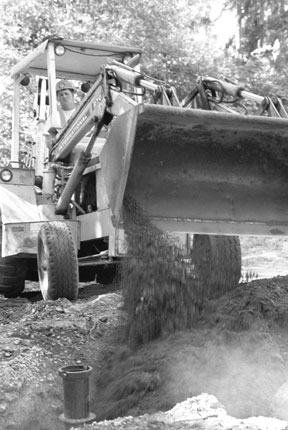The Freeland Water District wants to stay one step ahead of development.
In anticipation of future growth in the Freeland area, the district’s commissioners are adding a new well to the two the district already has.
According to the Tom Roehl, the district’s planning and project engineer, getting the new well drilled and pumping water will take a few years and requires approval from the state Department of Ecology.
The district gets its water from two deep wells off Scenic Road. The new well is located about 1,000 feet away from the existing wells.
The cost of the additional well is estimated to be between $80,000 and $100,000 and will include buying the land where the well is located, drilling and installation of the well, casings, a pump and water mains to connect the well to the district’s storage tank across the road.
The additional well will bring Freeland’s capacity to somewhere between 800 and 900 connections. Currently the district serves 336 connections on the system, and plans exist to add another 214 to bring the total on the existing system to 436. As it is now, the system can serve up to 550 connections.
“We are planning for the future, 10 and 20 years from now,” Roehl said. “This is what we are supposed to be doing now, so that we are ready for future growth in our district.”
The additional well is part of the district’s 1997 Comprehensive Plan. Roehl said when the well site came up for sale, the owners of the property were planning to drill their own well. The district offered to pay the difference –about $15,000 — between setting up the well for use for one property and for use as part of the district’s system. The property owners accepted the deal.
The new well is located on a 10-acre site that is being split into two five-acre lots. A private party will own one lot and the water district will own the other.
Once the new well starts pumping water, Freeland Water District customers probably won’t be able to tell the difference.
“It is the same quality as our existing wells, said Roehl.
District commissioners and Roehl know that the additional well water may not be needed for years. Right now, the district doesn’t even use both of the wells it has. Under normal conditions, the district draws water from only one well. Having a second well gives the district a backup to use during periods of high demand.
To bring the new well online, the district must get approval from the Washington State Department of Ecology and apply for additional water rights from the new source.
Freeland is classified by the Ecology as a Type A water system, meaning it serves more than 15 customers.
Fed by rain, which is in ample supply on South Whidbey, the district’s three wells are expected to be able to supply all the water the district needs in the future. Vin Sherman, and environmental specialist with the Island County Health Department said Whidbey Island could not be a better place for using ground water. The water is so plentiful that many people hardly give its source a thought when they turn on the tap.
In truth, getting water on the island is a bit complicated. While wells do the job on South Whidbey, Oak Harbor and NAS Whidbey have their water piped to the island from the Skagit River. In the Coupeville area, some wells are becoming unusable due to salt water intrusion from Puget Sound.
If the populations of South and Central Whidbey grow to the density of that in Oak Harbor, salt water intrusion could become a serious issue due to the demand on ground water sources.
“Many people think there is one water system serving the county,” Sherman said. “The problem with wells here is sea water intrusion. They don’t go dry.”
Sherman said South Whidbey wells have the lowest risk of salt water intrusion because of the geology of the land and the amount of rain that falls over the area.



